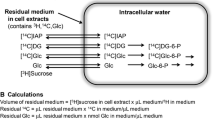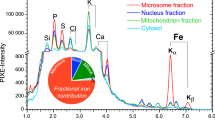Abstract
Dynamic studies of iron metabolism in brain are generally unavailable despite the fact that a number of neurologic conditions are associated with excessive accumulation of iron in central nervous tissue. Cortical non-neuronal (glial) cultures were prepared from fetal mouse brain. After 13 days the cultures were exposed to radiolabeled iron. Brisk and linear total iron uptake and ferritin iron uptake occurred over 4 hours. When methylamine or ammonium chloride was added, (both known inhibitors of transferrin iron release because of their lysosomotropic properties), total iron uptake was diminished. Further studies indicated that meth-ylamine inhibits glial cell ferritin iron incorporation. Glial cell iron transport is similar to previously reported neuronal cell iron transport (1) but glial cell iron uptake proceeds at a faster rate and is more susceptible to the inhibition of certain lysosomotropic agents. The data reinforces the likelihood that iron uptake by nervous tissues is transferrin-mediated.
Similar content being viewed by others
References
Swaiman, K. F., andMachen, V. L. 1984. Iron uptake by mammalian cortical neurons. Ann. Neurol. 16:66–70.
Elejalde, B. R., Elejalde, M. M. J., andLopez, F. 1979. Hallervorden-Spatz disease. Clin. Genet. 16:1–16.
Goldberg, W., andAllen, N. 1979. Nonspecific accumulation of metals in the globus pallidus in Hallervorden-Spatz disease. Trans. Am. Neurol. Assoc. 104:106–108.
Swaiman, K. F., Smith, S. A., Trock, G. L., andSiddiqui, A. R. 1980. Sea-blue histiocytes, lymphocytic cytosomes and59Fe studies in Hallervorden-Spatz disease. (Abstract). Neurology 30:379.
Swaiman, K. F., Smith, S. A., Trock, G. L., andSiddiqui, A. R. 1983. Sea-blue histiocytes, lymphocytic cytosomes, and59Fe-studies in Hallervorden-Spatz syndrome. Neurology 33:301–305.
Szanto, J., andGallyas, F. 1966. A study of iron metabolism in neuropsychiatric patients; Hallervorden-Spatz disease. Arch. Neurol. 14:438–442.
Vakili, S., Drew, A. L., Von Schuchling, S., Becker, D., andZeman, W. 1977. Hallervorden-Spatz syndrome. Arch. Neurol. 34:729–738.
Zimmerman, A. W., Karimeddini, M. K., Ramsby, G. R., andZimmer, A. E. 1981. Hallervorden-Spatz syndrome: Increased cerebral uptake of59Fe and demonstration of striatal iron deposits on CT scan. (Abstract). Neurology 31 (pt 2):129.
Earle, K. M. 1968. Studies on Parkinson's disease including x-ray fluorescent spectroscopy of formalin fixed brain tissue. J. Neuropath. Exp. Neurol. 27:1–14.
Hallgren, B., andSourander, P. 1958. The effect of age on the non-haemin iron in the human brain. J. Neurochem. 3:47–51.
Lhermitte, J., Kraus, W. M., andMcAlpine, D. 1924. Etude des produits de desintegration et des depots du globus pallidus dans un cas de syndrome parkinsonien. Rev. Neurol. 1:356–361.
Rojas, G., Asenjo, A., Chiorino, R., Aranda, L., Rocamora, R., andDonoso, P. 1965. Cellular and subcellular structure of the ventrolateral nucleus of the thalamus in Parkinson disease. Deposits of iron. Confin. neuron. 26:362–376.
Goodman, L. 1953. A clinico-pathologic analysis of twenty-three cases with a thoery on pathogenesis. J. Nerv. & Ment. Dis. 118:97–130.
Akelaitis, A. J. 1944. Atrophy of basal ganglia in Pick's disease. Arch. Neurol. Psychiat. 51:27–34.
Ehmann, W. D., Alauddin, M., andHossain, T. I. M., Markesbery, W. R. 1984. Brain trace elements in Pick's disease. Ann. Neur. 15:102–104.
Merritt, H. H., Adams, R. D., andSolomon, H. C. 1946. Neurosyphilis. Oxford, England. Oxford University Press.
Vitale, L., Opitz, J. M., andShahidi, N. T. 1969. Congenital and familial iron overload. 280:642–645.
Olson, J. E., andHolzman, D. 1980. Respiration in rat cerebral astrocytes from primary culture. J. Neurosci. Res. 5:497–506.
Swaiman, K. F., Neale, E. A., Fitzgerald, S., andNelson, P. G. 1982. A method for large scale production of fetal mouse cerebral cortical cultures. Dev. Brain Res. 3:361–369.
Sher, P. K., andMachen, V. L. 1984. Properties of3H-diazepam binding sites on cultured murine glial and neurones. Dev. Brain Res. 14:1–6.
Nelson, C. V. 1964. Determination of serum iron using sulfonated diphenylphenanthroline. Am. J. Med. Technol. 30:71–80.
Cox, P. G., Harvey, N. E., Sciortino, C., andByers, B. R. 1981. Electron-microscopic and radioiron studies of iron uptake in newborn rat myocardial cells in vitro. Am. Assoc. Path. 102:151–159.
Morgan, E. H. 1981. Inhibition of reticulocyte iron uptake by NH4Cl and CH3NH2. Biochim. et Biophys. Acta. 642:119–134.
Lowry, O. H., Rosebrough, N. F., Farr, A. L., andRandall, R. J. 1951. Protein measurement with the Folin phenol reagent. J. Biol. Chem. 193:265–275.
Drysdale, J. W., andMunro, H. N. 1965. Small-scale isolation of ferritin for the assay of the incorporation of14C-labeled amino acids. Biochem. J. 95:851–858.
Barden, H. 1969. The histochemical relationship of neuromelanin and lipofuscin. J. Neuropathol. Exp. Neurol. 28:419–441.
Dfendini, R., Markesbery, W. R., Mastri, A. R., andDuffy, P. E. 1973. Hallervorden-Spatz disease and infantile neuroaxonal dystrophy. J. Neurol. Sci. 20:7–23.
Park, B. E., Netsky, M. G., andBetsill, W. L. 1975. Pathogenesis of pigment and spheroid formation in Hallervorden-Spatz syndrome and related disorders. Neurology 25:1172–1178.
Wigboldus, J. M., andBruyn, G. W. 1968. Hallervorden-Spatz diseas. In: Vinken, P. J., and Bruyn, G. W. (eds.), Handbook of clinical neurology: diseases of the basal ganglia. Vol. 6 Amsterdam: North-Holland Publishing Co., 604–631.
Newman, R., Schneider, C., Sutherland, R., Vodinelich, L., andGreaves, M. 1982. The transferrin receptor. Trends. Biochem. Sci. 7:397–400.
Octave, J-N., Schneider, Y-J., Trouet, A., andCrichton, R. R. 1983. Iron uptake and utilization by mammalian cells. I: Cellular uptake of tranferrin and iron. Trends Biochem. Sci. 8:217–220.
Octave, J-N. Schneider, Y-J., Crichton, R. R., andTrouet, A. 1981. Transferrin uptake by cultured rat embryo fibroblasts. Eur. J. Biochem. 115:611–618.
Author information
Authors and Affiliations
Rights and permissions
About this article
Cite this article
Swaiman, K.F., Machen, V.L. Iron uptake by glial cells. Neurochem Res 10, 1635–1644 (1985). https://doi.org/10.1007/BF00988605
Accepted:
Issue Date:
DOI: https://doi.org/10.1007/BF00988605




